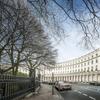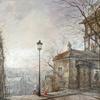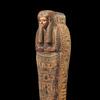
Norman Lewis: Looking East
http://www.michaelrosenfeldart.com/
(NEW YORK, Nov 16, 2018) Michael Rosenfeld Gallery is pleased to present its fifth solo exhibition for abstract expressionist Norman Lewis (American, 1909-1979). Scheduled to be on view from November 16, 2018 to January 26, 2019, Norman Lewis: Looking East explores for the first time the profound impact of Asian thought, philosophy, literature and art on the life-long work of the artist. On view will be a selection of paintings, works on paper, and never-before-viewed artist sketchbooks (the latter are on loan from the Norman Lewis Archive); works included in the exhibition date from 1948 to 1977.
Two distinctive elements of Lewis’ abstract practice – calligraphic and atmospheric abstraction – reflect the innovative incorporation of Eastern influences throughout his oeuvre. By way of his own literary and creative education and his immersion in the New York art world, Lewis’ work is a continuation of his intellectual pursuits within these realms. As a natural starting point, Lewis’ extensive library reveals a fascination with Eastern thought and aesthetics. From a booklet on Japanese puppets to multi-volume tomes on the art of India, what Lewis was reading and digesting reflects the immense range of inspiration that he encountered on a daily basis within his very own library. Many avant-garde artists of Lewis’ generation looked to Asian thought and aesthetics “to forge an independent artistic identity that would define the modern age – and the modern mind – through a new understanding of existence, nature, and consciousness.”[1] Artists in Lewis’ circle, amongst them Mark Rothko, David Smith, Ad Reinhardt, and Adolph Gottlieb, drew ideas from Eastern religions, Zen Buddhism and Carl Jung’s theories on the unconscious.
Predating this trend, early modernist artists looked to writings on Chinese and Japanese art by Ernest Fenollosa, who in turn influenced Arthur Wesley Dow, author of Composition (Doubleday Page & Company, 1923, originally published 1899), a manual for students and teachers which “introduced the Japanese approach to abstraction to the New York avant-garde.”[2] Lewis’ personal copy of the book fittingly includes doodles of his own, sketched after exercises illustrating principles of line and composition. Like many prominent abstract expressionists, Lewis was also reading and digesting books about Chinese art and calligraphy, including Lucy Driscoll and Kenji Toda’s Chinese Calligraphy (The University of Chicago Press, 1935), with its informative illustrations and passages explaining the basics of calligraphic content, form and technique, and Chiang Yee’s The Chinese Eye: An Interpretation of Chinese Painting (Frederick A. Stokes Co., 1937). These seminal books, along with other influential selections from Lewis’ vast library, will be on view in the exhibition.
With these literary and visual sources on his mind, Lewis joined Willard Gallery in 1946, where these influences were cemented by the artist’s engagement with Marian Willard and her roster of artists, most notably Mark Tobey, whose calligraphic style was influenced by travels to and studies in China and Japan, and Genichiro Inokuma, with whom Lewis developed a close friendship and dialogue and who stated that Willard handled artists with an “oriental feeling.”[3] Inokuma lived in New York from 1955 to 1975 and was a familiar presence in abstract art circles, exhibiting his calligraphic abstractions in ten one-man exhibitions at the Willard Gallery. Inokuma made an impression on Lewis and did much to reinforce his admiration of Asian art.
Lewis’ first solo exhibitions at the gallery were held in 1949 and 1950, and reviews of his work from the time consistently described Lewis’ work as delicate, lyrical and poetic – adjectives with strong ties to historic Chinese and Japanese art. Indeed, as early as 1950, a New York Times review of his work reflected the visual connection with an Eastern aesthetic: “There is an almost-Chinese finesse in the ways in which he indicates a flowering bush or hills at sunset.” Work from the 1950s increasingly reflected the calligraphic abstraction that cemented his reputation and throughout the decade, other critics noted that his works inspired by nature reflected “a tour-de-force of chinoise delicacy” (ARTnews, November 1954) and an “[evident] kinship with Oriental painters.” (The New York Times, February 1957).
In addition to artists in her circle, Willard’s own interests for the gallery’s curriculum were instrumental to Lewis’ artistic development as he continued to work in his own unique abstractionist vocabulary. A founding member and long-time trustee of the Asia Society, Willard “was one of the art dealers who played a significant role in the turn of American abstraction to Asian themes and was perhaps the most consistent champion of abstractionists with Asian interests.”[4] She surrounded herself with a group of artists and writers whose interests in Eastern cultures mirrored her own. These ties swirled around Lewis. In 1952, Willard’s friend Nancy Wilson Ross, a Buddhist scholar and expert on Eastern religions, wrote to Lewis suggesting possible titles for his paintings, related to celestial bodies and astronomy.[5] Lewis’ atmospheric and calligraphic compositions of this time reflect these spiritual and visionary themes.
In addition, thematic exhibitions organized by Willard while Lewis was in the gallery’s stable included surveys of Japanese screens (1954, 1956, 1960), Indian miniatures (1957) and The Heroic Encounter (1958), an exhibition conceived by photographer, writer and social activist Dorothy Norman, which presented universal and “mythmaking” symbols throughout Eastern and Western art historical traditions. In his personal copy of the catalogue, Lewis’ interest in concepts from the I Ching are evident and other publications from his library further reflect an interest in Chinese philosophy, including those expounding on Confucian and Taoist thought. Further throughout his library, Willard’s imprint is readily felt: for example, the book Nature, Man, and Woman by British philosopher Alan Watts, who popularized Eastern philosophy in the West, was gifted by Willard to Lewis for Christmas in 1958. Lewis’ interests were encouraged by Willard’s own, whose gifts of inscribed books throughout the years display a dealer-artist relationship based on cultural enrichment.
Norman Lewis: Looking East will be accompanied by a fully-illustrated catalogue with new scholarship by Andrianna Campbell and Tetsuya Oshima, Ph.D., Associate Professor at Graduate School of Integrated Arts and Sciences, Hiroshima University.
About Norman Lewis
Known for his calligraphic abstract compositions, Norman Lewis (1909-1979) was a vital member of the first generation of abstract expressionists. He was the sole African American artist of his generation who became committed to issues of abstraction at the start of his career and continued to explore them throughout his lifetime. Lewis’ art derived energy from his vast interests in music – both classical and jazz - as well as nature, ancient ceremonial rituals, and social justice/equality issues central to the civil rights movement.
A native of New York City, Norman Wilfred Lewis was born to St. Kitts immigrants Diana and Wilfred Lewis. The Lewis family lived in Harlem, and as a youth, Lewis held various jobs throughout his schooling but knew he wanted to be an artist from the age of ten. In 1929, Lewis found work as a seaman on a freighter and spent several years traveling throughout South America and the Caribbean, meeting local people and witnessing firsthand the poverty of Bolivia, Uruguay, Jamaica, and elsewhere. Upon his return to the United States, Lewis settled back in New York City.
In the early 1930s, Lewis met artist and educator Augusta Savage, who ran an arts school in Harlem and was involved with lobbying the Works Progress Administration (WPA) to hire more black artists. From 1933 to 1935, he took classes at the Savage School of Arts and Crafts and attended Columbia University Teachers College. Lewis’s deep commitment to social and economic equality led him to join the Artists Union, which was organized to protect the rights of artists and workers. A regular at 306, a cultural center in Harlem that attracted musicians, writers and young artists, Lewis was a co-founder of the Harlem Artists Guild (HAG) in 1935. In 1936, he began working for the WPA’s Federal Arts Project, teaching classes. Lewis’ art at the time was grounded in social realism and focused on the lives and struggles of black Americans, but in the 1940s, he began to explore abstraction. While he remained active in the struggle for civil rights throughout his life, Lewis was skeptical about the power of art to effect change, explaining in a 1968 Archives of American Art interview with Henri Ghent, “one of the things in my own self education, was the discouraging fact that painting pictures of protest didn't bring about any change.”
In 1945, Alain Locke included Lewis’ work in the exhibition The Negro Artist Comes of Age: A National Survey of Contemporary American Artists, and the following year, Lewis joined the growing number of New York abstract artists represented by Willard Gallery. From his first solo show at Willard in 1949 to the mid-1950s, Lewis’ reputation steadily grew, and he developed his own individual style consisting of calligraphic, fluid forms suggesting groups of figures engaged in kinetic activity. Traveling in the same circles as prominent abstractionists, Lewis befriended Ad Reinhardt, Jackson Pollack, Charles Seliger, Franz Kline, and Willem de Kooning. In 1950, he was the only black artist to participate in the famous closed-door sessions defining abstract expressionism held at Studio 35, organized by de Kooning and Kline and moderated by Museum of Modern Art Director, Alfred J. Barr. A year later, MoMA included his work in the exhibition Abstract Painting and Sculpture in America.
Throughout his career, Lewis pursued his unique artistic vision while also remaining committed to his political beliefs. He was a founding member of the Spiral Group, and from 1965 to 1971, he taught for HARYOU-ACT, Inc. (Harlem Youth in Action), an antipoverty program designed to encourage young men and women to stay in school. In 1969, Lewis joined Benny Andrews, Romare Bearden, Clifford Joseph, Roy DeCarava, Alice Neel, and others in picketing the infamous Harlem on My Mind show at The Metropolitan Museum of Art. That same year, he, Bearden, and Ernest Crichlow co-founded Cinqué Gallery, dedicated to fostering the careers of emerging artists of color. A recipient of a National Endowment for the Arts Grant (1972), a Mark Rothko Foundation Individual Artists Grant (1972), and a Guggenheim Memorial Fellowship (1975), Lewis had his first retrospective exhibition in 1976 at the CUNY Graduate Center, New York.
In 1998, The Studio Museum in Harlem presented Norman Lewis: Black Paintings, 1946-1977 and most recently, in 2015, the Pennsylvania Academy of Fine Arts (PAFA) organized the traveling survey Procession: The Art of Norman Lewis, his first comprehensive museum overview. Curated by Ruth Fine, this landmark survey was accompanied by an award-winning monograph featuring new scholarship from Fine along with essays by David Acton, Andrianna Campbell, David C. Driskell, Jacqueline Francis, Helen M. Shannon and Jeffrey C. Stewart. On March 20, 2016, CBS Sunday Morning celebrated this exhibition with a feature anchored by correspondent Jim Axelrod.
Since his death in 1979, his work has been celebrated in numerous exhibitions; significant recent museum group exhibitions include Abstract Expressionist New York at the Museum of Modern Art (2010); From the Margins: Lee Krasner and Norman Lewis (2014, curated by Norman Kleeblatt) at The Jewish Museum (NYC); Postwar-Art between the Pacific and Atlantic, 1945-1965, (2016, curated by Katy Siegal and Okwui Enwezor) at the Haus der Kunst (Munich); The Color Line: African American Artists and the Civil Rights in the United States (2016, curated by Daniel Soutif) at Musée du Quai Branly, Paris; Abstract Expressionism, curated by David Anfam for the Royal Academy of Arts, London, England (2016); Art of Rebellion: Black Art of the Civil Rights Movement at the Detroit Institute of Arts (2017); and Ten Americans: After Paul Klee at the Zentrum Paul Klee in Bern, Switzerland and The Phillips Collection in Washington, DC (2017). Most recently, Lewis’ work was on view in the large-scale exhibition Histórias Afro-Atlânticas at the Museu de Arte de São Paulo (MASP) and Instituto Tomie Ohtake in São Paulo, Brazil.
Norman Lewis is represented in the permanent collections of numerous museums, including the Art Institute of Chicago (IL); Bermuda National Gallery (Hamilton); Blanton Museum of Art, University of Texas (Austin); The Cleveland Museum of Art (OH); The Metropolitan Museum of Art (New York, NY); Museum of Fine Arts, Boston (MA); Museum of Modern Art (New York, NY); National Gallery of Art (Washington, DC); Newark Museum (NJ); Philadelphia Museum of Art, (PA); Smithsonian American Art Museum (Washington, DC); The Studio Museum in Harlem (New York, NY); Whitney Museum of American Art (New York, NY); Virginia Museum of Fine Arts (Richmond); and Yale University Art Gallery, Yale University (New Haven, CT).
More information on Norman Lewis (1909-1979)
Around the world, the work of Norman Lewis can be viewed in the following Museum exhibitions: Solidary & Solitary: The Joyner/Giuffrida Collection
Snite Museum of Art, University of Notre Dame, Notre Dame, IN
August 18–December 15, 2018
Soul of a Nation: Art in the Age of Black Power
Brooklyn Museum of Art, Brooklyn, NY
September 14, 2018–February 3, 2019
Painting the Night
Centre Pompidou-Metz, Metz, France
October 13, 2018–April 15, 2019
I, Too, Sing America: The Harlem Renaissance at 100
Columbus Museum of Art, Columbus, OH
October 19, 2018–January 20, 2019
Posing Modernity: The Black Model from Manet and Matisse to Today
The Miriam and Ira D. Wallach Art Gallery, Lenfest Center for the Arts, Columbia University, New York, NY
October 24, 2018–February 10, 2019
Michael Rosenfeld Gallery
Michael Rosenfeld Gallery has championed the work of Norman Lewis for over twenty-five years and in 2014, the gallery became the exclusive representative of the Artist’s Estate. Michael Rosenfeld Gallery specializes in 20/21 century American art. Established in 1989 by Michael Rosenfeld, the gallery opened its doors to promote the breadth of American art and those artists—known or unknown—that contributed to the establishment of surrealism, social realism, abstract expressionism, figurative expressionism and geometric abstraction. Michael Rosenfeld Gallery is located at 100 Eleventh Avenue, New York, NY, 10011. Gallery hours are Tuesday through Saturday, 10:00am–6:00pm.
Press Inquiries
Dan Munn, Communications Associate
dm@michaelrosenfeldart.com, 212.247.0082
[1] Alexandra Munroe, “The Third Mind: American Artists Contemplate Asia, 1860-1989,” Exhibitions, Solomon R. Guggenheim Museum, New York, NY, January 30 - April 19, 2009, https://www.guggenheim.org/exhibition/the-third-mind-american-artists-contemplate-asia-1860-1989, accessed November 2018[2] Munroe, “Japanese Artists in the American Avant-garde, 1945–1970,” Contemporary Japanese Art in America I: Arita, Nakagawa, Sugimoto exh. cat (New York: Japan Society, 1987), 12-20, footnote number 20[3] Genichiro Inokuma as quoted in Bert Winther-Tamaki, “The Asian Dimensions of Postwar Abstract Art: Calligraphy and Metaphysics,” in Alexandra Munroe, The Third Mind: American Artists Contemplate Asia, 1860-1989 exh. cat. (New York: Solomon R. Guggenheim Museum, 2009), 147[4] Winther-Tamaki, “The Asian Dimensions of Postwar Abstract Art: Calligraphy and Metaphysics,” 147[5] Andrianna Campbell, “Chronology,” in Ruth Fine, ed., Procession: The Art of Norman Lewis exh. cat. (Philadelphia: Pennsylvania Academy of the Fine Arts, 2015), 256
















